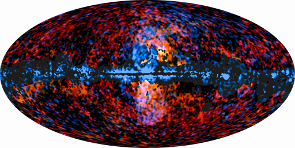New Planck maps reveal unseen details across the Milky Way
13 February 2012
An unambiguous detection of the Galactic Haze - a mysterious, diffuse emission from the central portion of the Milky Way - and the first all-sky map of carbon monoxide, whose emission traces the molecular clouds where stars are born, are among the results being presented by the Planck Collaboration at an international conference held from 13 to 17 February 2012, in Bologna, Italy. These results have been achieved during the complex task of identifying and removing the foreground contamination due to Galactic and extragalactic emission that obscures the Cosmic Microwave Background.The primary goal of ESA's Planck satellite is to observe the Cosmic Microwave Background (CMB), the relic radiation from the Big Bang, and to measure its tiny fluctuations across the sky with unprecedented accuracy. These anisotropies contain all-important information about the constituents of the Universe and the origin of cosmic structure. Along with the CMB, Planck also sees almost every source that shone throughout cosmic history. This includes emission from individual galaxies and, most notably, from the interstellar medium (ISM) in our Galaxy, the Milky Way. Diffuse emission from this mixture of gas and dust represents the dominant source of foreground contamination to the CMB at all frequencies of interest across the entire plane of our Galaxy.
A careful and complex process of data 'cleaning' is necessary to peel away the 'layers' of foreground emission in order to access the CMB's rich reservoir of cosmological information. Removing these layers reveals a wealth of data that is crucial for many other fields in astronomy. In particular, new facets of the Milky Way's diffuse emission and of its large-scale distribution of stellar nurseries are unveiled in two new all-sky images that are being presented at the conference "Astrophysics from the radio to submillimetre – Planck and other experiments in temperature and polarization" held from 13 to 17 February 2012 in Bologna, Italy.
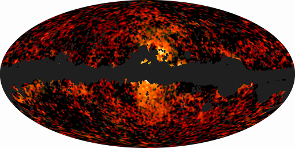 |
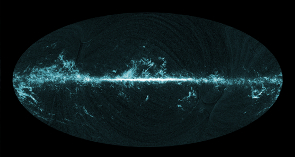 |
| The mysterious Galactic Haze (left) and the all-sky distribution of molecular gas (right) seen by Planck. Credit: ESA/Planck Collaboration | |
"The lengthy and delicate task of foreground removal provides us with excellent data sets that are being used to shed new light on several hot topics in Galactic and extragalactic astronomy," comments Jan Tauber, Planck Project Scientist at ESA. "In the recent past we have made important strides with Planck in understanding the properties of some previously poorly constrained components of our Galaxy, and this week we present new results revealing other intriguing players in the microwave sky. Together, they show that Planck is providing important new information to our picture of the Milky Way and the Universe at large," he adds.
The Galactic foreground emission measured by Planck is mostly produced by free electrons and dust present in the ISM. Electrons radiate mainly via two physical processes: they emit synchrotron radiation as they spiral across the Galactic magnetic field, and free-free (or bremsstrahlung) radiation when being decelerated in the presence of protons or heavier ions. Both synchrotron and free-free radiation are most intense at the lowest frequencies probed by Planck. Interstellar dust on the other hand, with temperatures typically below 20 K, shines brightly in the far-infrared and sub-millimetre portions of the electromagnetic spectrum, thus contributing to the emission detected by Planck's high-frequency channels. In addition, nano-scale spinning grains of dust emit at Planck’s lowest frequencies – the so-called anomalous microwave emission.
Fortunately for astronomers, these four radiation processes exhibit quite different spectral properties. With its nine frequency channels, spanning the range between 30 and 857 GHz, Planck boasts unprecedented spectral coverage that greatly facilitates the task of identifying and isolating the various sources of emission. Apparently, however, the four processes do not completely account for all Galactic foreground emission.
"Interestingly, we detect residual diffuse emission in the surroundings of the Galactic Centre even after having removed all the 'expected' contributions due to synchrotron and free-free radiation, thermal dust, and spinning dust," explains Krzysztof M. Gorski from the Jet Propulsion Laboratory (JPL), Caltech, Pasadena, U.S.A, and Warsaw University Observatory, Poland. Gorski is a Planck Collaboration scientist and one of the Co-Investigators of the Low Frequency Instrument (LFI) on board Planck. "To take advantage of both the excellent quality and complexity of Planck measurements, new foreground separation methods were developed by the members of Planck Collaboration," he adds.
Hints of this component, dubbed Galactic Haze, were already present in data from NASA's Wilkinson Microwave Anisotropy Probe (WMAP), but the detection had – at least until now – remained uncertain. "Thanks to Planck's high frequency measurements we can better characterise thermal dust emission, and this, combined with refined data-analysis tools, means that the detection of the Galactic Haze is now unambiguous," adds Davide Pietrobon from JPL/Caltech, another Planck team member.
While the detection may be definitive, the origin of this emission remains unclear. "The Planck results that we are presenting at the conference show that the Galactic Haze is synchrotron-like in nature," notes Gorski. This explanation is consistent with the Galactic 'bubbles' detected in 2010 by NASA's Fermi Gamma-ray Space Telescope. Such high-energy emission correlates spatially quite well with the Galactic Haze seen at much lower energies; the two might indeed be a manifestation of the same population of electrons via different radiation processes.
"Synchrotron emission associated with the Galactic Haze, however, exhibits distinctly different characteristics from the synchrotron emission seen elsewhere in the Milky Way, and we're trying to understand why," adds Gorski. Diffuse synchrotron emission in the Galaxy is understood as radiation from highly energetic electrons that have been accelerated in shocks created by supernova explosions. Compared to this well-studied emission, the Galactic Haze has a 'harder' spectrum, meaning that its emission does not decline as rapidly with increasing frequency. Several explanations have been proposed for this unusual behaviour, including enhanced supernova rates, galactic winds and even annihilation of dark-matter particles. Thus far, none of them have been confirmed and the issue remains open.
Another source of foreground emission seen by Planck is represented by molecular clouds, the dense and compact regions throughout the Milky Way where gas and dust clump together. The vast majority of gas in these clouds consists of molecular hydrogen (H2), and it is in these cold regions that stars are born. Since cold H2 does not easily radiate, astronomers trace these cosmic cribs across the sky by targeting other molecules, which are present there in very low abundance but radiate quite efficiently. The most important of these tracers is carbon monoxide (CO), which emits a number of rotational emission lines in the frequency range probed by Planck's High Frequency Instrument (HFI).
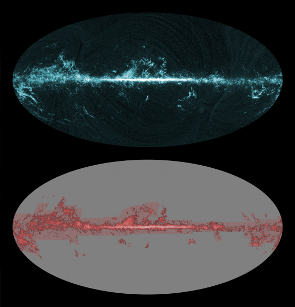 |
|
All-sky image of molecular gas seen by Planck and previous surveys. Credit: ESA/Planck Collaboration (upper oval); T.Dame et al., 2001 (lower oval) |
Emission lines affect a very limited range of frequencies compared to the broad range to which each of Planck’s detectors is sensitive, and are usually observed using spectrometers. But some CO lines are so bright that they actually dominate the total amount of light collected by certain detectors on Planck when they are pointed towards a molecular cloud.
"Thanks to special foreground removal techniques, Planck turns out to be an excellent detector of CO across the entire sky," comments Jonathan Aumont from Institut d'Astrophysique Spatiale (IAS), Universite Paris XI, Orsay, France, a Planck Collaboration scientist. "We are excited to be presenting the first all-sky map of CO ever compiled," he adds.
Surveys of CO undertaken with ground-based radio telescopes are extremely time consuming, and are limited to portions of the sky where molecular clouds are known to exist. The largest CO surveys thus far have concentrated on mapping the full extent of the Galactic Plane, where most clouds are concentrated, leaving large areas of the sky unobserved. "The great advantage of the CO map compiled with Planck is that it allows us to find concentrations of molecular gas where we don't expect them," explains Aumont. This is particularly important for the portions of the sky at high galactic latitudes, where clouds that are relatively close to the Solar System might be projected on the all-sky map. Planck's high sensitivity to CO also means that even very low-density clouds can be detected, and new details can be revealed in clouds that were already known.
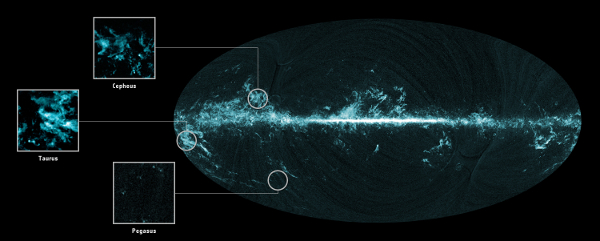 |
|
All-sky image of molecular gas and three molecular cloud complexes seen by Planck. Credit: ESA/Planck Collaboration |
"We now have a 'treasure map' of previously unknown islands of molecular gas that we plan to explore with follow-up observations," notes François Boulanger from IAS, another Planck Collaboration scientist. Further studies will allow a detailed investigation of the physical and chemical conditions that lead to the formation of molecular clouds, shedding new light on the very early phases of star formation.
"The insights into the Galactic Haze and the CO distribution that are being provided by Planck give us a fresh view on the intricate network of processes taking place in the ISM in our Galaxy," comments Tauber. The results presented this week demonstrate that the collaboration is making great progress in identifying and isolating all contributions to the foreground emission. "We can look forward to finally being able to accurately characterise all major foregrounds and to unveil the CMB in unprecedented detail," he concludes.
Notes for editors
ESA's Planck mission maps the sky in nine frequencies using two state-of-the-art instruments, designed to produce high-sensitivity, multi-frequency measurements of the diffuse sky radiation: the Low Frequency Instrument (LFI) includes the frequency bands 30–70 GHz, and the High Frequency Instrument (HFI) includes the frequency bands 100–857 GHz.
The results described here are among a wide range of topics being presented this week (13-17 February 2012) at the conference "Astrophysics from the radio to submillimetre – Planck and other experiments in temperature and polarization" held in Bologna, Italy.
The Planck Scientific Collaboration consists of all the scientists who have contributed to the development of the Planck mission, and who participate in the scientific exploitation of the Planck data during the proprietary period, which nominally ends with the release of the scientific products to the community 3.5 years after launch, i.e. in January 2013. These scientists are members of one or more of four consortia: the LFI Consortium, the HFI Consortium, the DK-Planck Consortium, and ESA's Planck Science Office.
The two European-led Planck Data Processing Centres are located in Paris, France and Trieste, Italy, and the U.S. Planck Data Center (USPDC) is in Pasadena, California, U.S.A.
Contacts
Krzysztof M. Gorski
Jet Propulsion Laboratory/Caltech
Pasadena, California, USA and
Warsaw University Observatory, Poland
Phone: +1-818-648-9670
Email: krzysztof.m.gorski jpl.nasa.gov
jpl.nasa.gov
Davide Pietrobon
Jet Propulsion Laboratory/Caltech
Pasadena, California, USA
Phone: +1-626-319-6507
Email: Davide.Pietrobon jpl.nasa.gov
jpl.nasa.gov
Jonathan Aumont
Institut d'Astrophysique Spatiale (IAS)
Universite Paris XI
Orsay, France
Phone: +33-1-69-85-8541
Email: jonathan.aumont ias.u-psud.fr
ias.u-psud.fr
François Boulanger
Institut d'Astrophysique Spatiale (IAS)
Universite Paris XI
Orsay, France
Phone: +33-1-69-85-8573
Email: francois.boulanger ias.u-psud.fr
ias.u-psud.fr
Jan Tauber
ESA Planck Project Scientist
Research and Scientific Support Department
Directorate of Science and Robotic Exploration
ESA, The Netherlands
Phone: +31-71-565-5342
Email: jan.tauber esa.int
esa.int

